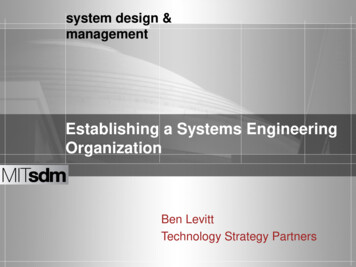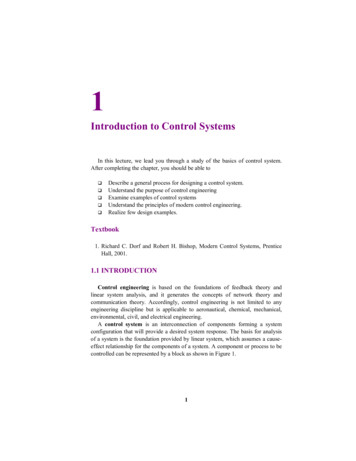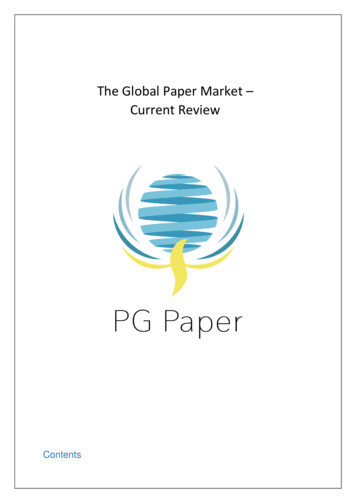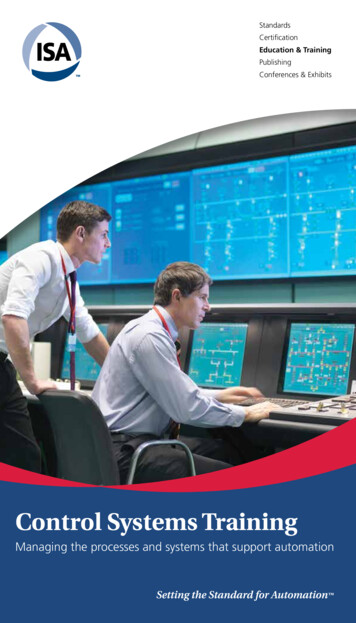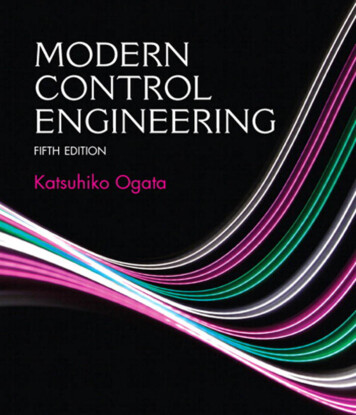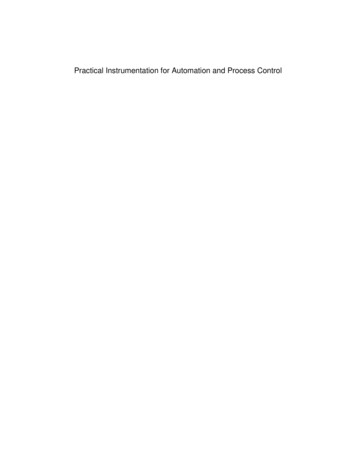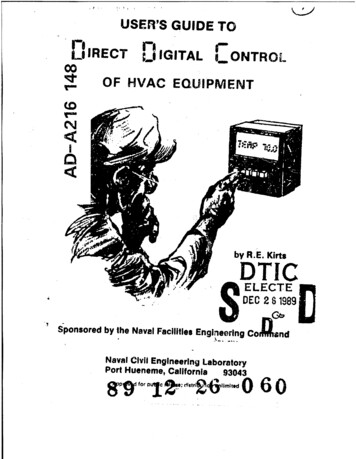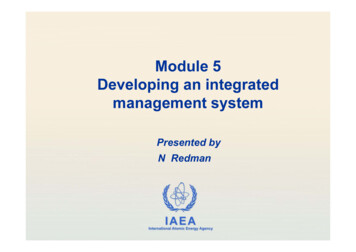
Transcription
PAPER 6 - INFORMATION SYSTEMS CONTROL AND AUDITChpt12345678NameConcepts Of Governance and Management of Information SystemsInformation Systems ConceptsProtection Of Information SystemsBusiness Continuity Planning and Disaster Recovery PlanningAcquisition, Development and Implementation of Information SystemsAuditing of Information SystemsInformation Technology Regulatory IssuesEmerging TechnologiesChapter Chapter 1COBIT tegies- Benefit- GEIT- Principles- IT Gov- Component- Terminate- Dimension- Enablers- Transfer- IT Steering CommitteeRiskCompliance- RM- Governance- Categories of ITStrategy PlanningPages7914812551171- Tolerate- IT Compliance- Aligning IT Objective- Ass & Eval System of IC- Treat- Turn backInternal Control - COSOGovernance - Major Benefits of GovernanceProviding stability and overcoming the limitations of organizational structure;S[SIM-BPO] [May 19]IImproving customer, business and internal relationships and satisfaction, and reducing internalterritorial strife by formally integrating the customers, business units, and external IT providers into aholistic IT governance framework; andMEnabling effective and strategically aligned decision making for the IT Principles that define the roleof IT, IT Architecture, IT Infrastructure and IT Investment & Prioritization.BDefining and encouraging desirable behaviour in the use of IT and in the execution of IT outsourcingarrangements;PImplementing and integrating the desired business processes into the enterprise;OAchieving enterprise objectives by ensuring that each element of theassigned and managed with a clearly understood and transparent decisions;missionand strategy are GEIT Governance - Benefits[Legal MPDC]GEIT is subset of Corp Govn. and facilitate implementation of framework of IS control within enterprisesas relevant & encompassing all key areasLegal It confirms compliance with legal and regulatory requirements.MIt ensure that the governance requirement for boards members are met.PIt ensure that IT related processes are overseen effectively and transparently.DIt ensure that IT related decision are made in line with the enterprises strategic & objectives.CIt provides a consistent approach integrated & aligned with the enterprises governance approach.Last Day Revision Point - ISCA - By Sanjay Zanwar, 97659743651
KGP of GEITEvaluate the GovernanceSystem:[EDM]Continually identify and engage with the enterprise's stakeholders, document anunderstanding of the requirements;Direct the GovernanceSystem:Inform leadership and obtain their support, buy-in and commitment. Guide thestructures, processes and practices for the governance of IT; andMonitor the GovernanceSystem:Monitor the effectiveness and performance of the enterprise’s governance of IT. IT Governance - Benefits[N14][Memory - User Value Of TECBAM]IT Governance is the system by which IT activities in a company or enterprises are directed and controlledto achieve business objective with the ultimate objective of meeting stakeholders needs.User Increased User satisfaction with IT ServicesValue Increased Value delivered through ent ITOfMore optimal utilization of IT resourcesTImproved transparency & understanding of IT's contribution to d businessEIT becoming an enabler for change rather than an inhibitorCImproved Compliance with relevant laws, regulation and policiesBBetter Cost performance of ITAImproved agility in supporting business needsMImproved mitigation of IT related risksIT Govn.GEITis -- is -- Subset of GEITSubset of corporate governanceGEITGEIT me IT Gov haiIT GovernanceEnterprise Governance has two dimensions:ParticularBusiness / Performance GovernanceProvideForward Looking view, Proactive approachFocusIts Business oriented, Focuses on strategy &value creationMonitored byBoardObjectiveHelping board to make strategicdecision, understand its risk appetiteand its key performanceConformance / Corporate governanceHistoric viewRegulatory requirementAudit CommitteeIncrease shareholder value byenhancing eco. PerformanceSome of Best practices of corporate governance:[RIM SEA]R - Clear assignment of responsibilities & decision-making authorities;I - Financial & managerial incentives to senior management & employees offered in an appropriate manner;M - Establishment of a mechanism for interaction & cooperation among board of directors, senior management &the auditorsS - Implementing strong Internal Control systems;E - Monitoring risk Exposures where conflicts of interest are likely to be particularly great. (E.g. Related partytransactions);A - Appropriate information flows internally (e.g. I.A. Report to BOD) & externally (e.g. XBRL to MCA). IT Steering Committee - Key Functions[Memory-SSC exam EDIT karke RDI me dalo]To Review & Approve Standards, policies and procedureSTo Review the Status of IS plans & budget & overall IT performanceSTo Resolve Conflict in deployment of ITCTo Establish size & scope of IT function & sets priorities within the scopeETo Make decision on all key aspects of IT deployment & ImplementationDTo Facilitate Implementation of IT Security within EntILast Day Revision Point - ISCA - By Sanjay Zanwar, 9765974365[RTP N19]2
TRDIToToToToEnsure that long & short range plans of the IT dept are in Tune with ent objectivesReport to the BOD on IT activities on a regular basisReview and approve major IT deployment projects in all their stagesApprove & Monitor key projects by measuring result of IT projects in terms of return on invst. etc Classification of Strategic Planning & Categories of IS PlansEnt. Strategic PlanDetermine overall plan of enterprisesIS Strategic Plan[EIRA]It is Primary plan by top management.Should align with enterprises strategic plan enablers are;1. Enterprises business strategy2. How IT Support Business3.Feasibility Study4. Risk Assessment5. Need for Senior managementIS Requirement PlanEvery enterprise needs to have clearly defined information architecture with theobjective of optimizing the organization.IS Application PlanThe information systems mgmt. can develop an information systems applications& facilities plan.COBIT 5.0Control Objectives for Information and Related Technology (COBIT) is a set of best practices for InformationTechnology management developed by Information Systems Audit & Control Association (ISACA) and ITGovernance Institute. It Aligns IT objective with business objectives. Allows bridge the gap between controlrequirement technical issue & Business risks Enable clear policy development & goods practice of IT Control & Helporg to increase value from IT COBIT 5.0 - Benefits[M18][SOO PIC HER]Provide generic framework which can be used by ent. of all sizes, whether commercial, not for profit orSpublic sectorOCOBIT 5 help enterprises to create optimal value from IT by maintaining a balance between realizingbenefits and optimizing risk levels and resource use.OComprehensive framework such as COBIT 5 enables enterprises in achieving their objective forgovernance & management of enterprise ITPICOBIT 5 enables clear policy development and good practice for IT management including increasedbusiness user satisfaction.CCOBIT 5 supports Compliance with law, regulations & contractual requirementsHCOBIT 5 enables IT to be governed and managed in a holistic manner for the entire enterprise, taking fullIT functional areas of responsibility, considering the IT related interests of stakeholders.ERCOBIT 5 help to manage IT related Risk and ensures compliance, continuity, security and privacy. COBIT 5 - Five Principle[ME IAS]MeetingEnterprises exist to create value for their stakeholders by maintaining a balanceMstakeholders needs between the realization of benefits & d optimization of risk & use of resourcesECovering enterpriseend to endCOBIT 5 integrates governance of ent. IT into ent. governance. It covers all functions& processes within the enterprise; COBIT 5 does not focus only on the ‘IT function’.IApplying SingleIntegrated frm.wrkThere are many IT related standards & best practices, each providing guidance on asubset of IT activities. COBIT 5 is a single & integrated framework.AEnabling HolisticApproachEfficient & effective governance & management of ent. IT require a holistic approach.It defines a set of enablers to support the implementation for GEIT. Enablers areanything that can help to achieve the objectives of the enterprise.SSeparatinggovernance frommanagementThe COBIT 5 framework makes a clear distinction between governance andmanagement. These two disciplines encompass different types of activities, requiredifferent organizational structures and serve different purposes.Last Day Revision Point - ISCA - By Sanjay Zanwar, 97659743653
COBIT 5.0 - Component[Nov 19] [CFPMM]Control ObjectiveProvide a complete set of high level req considered by mgmt for effective controlFrameworkOrganize IT gov objectives & Good practices by IT domainProcess DescriptionsThe process map to responsibility areas of plan, build, run and monitorMgmt GuidelinesHelp assign responsibility, agree on objectives measures performanceMaturity ModelsAssess maturity and capability per process and helps to address gaps COBIT 5.0 - Seven Enablers[M14][IPS is COPS]IInformation is pervasive throught any org & include all info. produced & used by the ent.PPrinciples, Policies and Framework are the vehicle to translate desired behaviour into practical guidance forday to day managementSCOPSPeople, Skills & Competencies r linked to people & r required for successful completion of all activitiesCulture, Eth. & Behaviour of Ind. & of ent very often understanding as success factor in governanceOrganisational StructureAre the key decision making entities in an enterprisesProcessesDescribe an organised set of practices and activities to achieve certain objectiveService Infrastructure and Applications includes infrastructure technology & application that provide theent. with IT processing & Service.Risk Management StrategiesTolerate /Accept RiskOne of the primary functions of management is managing risk. Some risks may be consideredminor because their impact and probability of occurrence is low. In this case, consciouslyaccepting the risk as a cost of doing business is appropriate.Terminate /EliminateIt is possible for a risk to be associated with the use of a particular technology, supplier, orvendor. The risk can be eliminated by replacing the technology with more robust products andby seeking more capable suppliers and vendors.Risk mitigation approaches can be shared with trading partners and suppliers. A good example isoutsourcing infrastructure management. In such a case, the supplier mitigates the risks havingTransfer / Shareaccess to more highly skilled staff than the primary organization. Risk also may be mitigated bytransferring the cost of realized risk to an insurance providerTreat / MitigateWhere other options have been eliminated, suitable controls must be devised andimplemented to prevent the risk from manifesting itself or to minimize its effects.Turn backWhere the probability or impact of the risk is very low, then management may decide to ignorethe risk. Internal Control as per COSO[N14][Memory - EACCM]ControlThis includes the elements that establish the control context in which specificEEnvironmentsaccounting systems and control procedures must operate.ARisk AssessmentThis includes the elements that identify and analyze the risks faced by anorganisation and the way the risk can be managed.CControl ActivitiesThis includes the elements that operate to ensure transactions are authorized, dutiesare segregated, adequate documents and records are maintained, assets and recordsare safeguarded.CInfo. &CommunicationThese r d elements, in which information is identified, captured & exchanged in atimely & appropriate form to allow personnel to discharge their responsibilities.MMonitoringThe internal control process must be continuously monitored with modifications madeas warranted by changing conditions.Last Day Revision Point - ISCA - By Sanjay Zanwar, 97659743654
Key Management Practices KMP for Risk Management[Memory - CAMDAR]Collect DataIdentify and collect relevant data to enable effective IT related riskCAnalyse RiskDevelop useful info. to support risk decisions that take into account risk factors.AMaintain a RiskMaintain an inventory of known risks and risk attributes, including expectedMProfilefrequency and current control activities.AArticulate RiskProvide info. on the current state of IT-related exposures & opportunities in a timelymanner to all required stakeholders for appropriate response.DDefine Risk mgmtaction portfolioManage opportunities and reduce risk to an acceptable level as a portfolio.RRespond to RiskRespond in a timely manner with effective measures to limit the magnitude of lossfrom IT related events. KMP for IT Compliances[May 19]CIdentify External ComplianceRequirementOn a continuous basis, identify and monitor for changes in local andinternational laws, regulations, and other external requirements that mustbe complied with from an IT perspective.OOptimize Response to ExternalRequirementReview and adjust policies, principles, standards, procedures andmethodologies to ensure that legal, regulatory and contractualrequirements are addressed and communicated.CConfirm External ComplianceConfirm compliance of policies, principles, standards, procedures andmethodologies with legal, regulatory and contractual requirementsAObtain Assurance of ExternalComplianceObtain & report assurance of compliance & adherence with policies,principles,standards,procedures & methodologies. KMP for Aligning IT Strategy with Enterprise Strategy [N19][N18, Nov 19][DAD Conduct Strategic Communication]Understand enterprisedirection:Consider the current enterprise environment & business processes, enterprisestrategy & future objectives. Consider also the external environment of theenterprise.Assess the current env,capabilities & PerformanceAssess the performance of current internal business and IT capabilities and externalIT services.Define the target ITcapabilitiesDefine the target business and IT capabilities. This should be based on theunderstanding of the enterprise environment.Conduct a GAP analysisIdentify the gaps between the current and target environments and consider thealignment of assets to optimize investment. Consider the critical success factors tosupport strategy execution.Create a st. plan that defines, in co-operation with relevant stakeholders. Include howDefine the strategic plan &IT will support IT-enabled investment programs, business processes, IT services androad map:IT assets.Communicate the ITstrategy & directionCreate awareness & understanding of the business and IT objectives throughcommunication to appropriate stakeholders & users throughout the enterprise.[N14, N18] KMP for Assessing & Evaluating the system of Internal control in an enterprises[Nov 19]Continuously monitor the IT control environment and control to meetMonitor Internal ControlMorganizational objectivesRReview Business ProcessControl EffectivenessReview the operation of controls, including monitoring and test evidence.This provides the business with the assurance of control effectiveness.PPerform Control SelfassessmentEncourage management and process owners to take positive ownership ofcontrol improvement through self – assessment.DIdentify & report controldeficienciesIdentify control deficiencies and analyze and identify their underlying rootcauses. Escalate control deficiencies and report to stakeholders.Last Day Revision Point - ISCA - By Sanjay Zanwar, 97659743655
EEnsure that assuranceproviders are independent &qualifiedEnsure that the entities performing assurance are independent from thefunction, groups or organizations.PAIPlan Assurance InitiativePlan assurance initiatives based on enterprise objectives and conformanceobjectives, assurance objectives and sufficient knowledge of theenterprise.SAIScope Assurance InitiativeDefine and agree with management on the scope of the assuranceinitiative, based on the assurance objectives.Execute Assurance InitiativeExecute the planned assurance initiative. Report on identified findings.Provide positiveassurance opinionsandrecommendations forimprovement relating to external compliance and internal control systemresidual risks.EAIKey Metrics for Assessing Compliance ProcessCost of IT non-compliance, including settlements and fines;Number of IT related non-compliance issues reported to the board or causing publiccomment or embarrassment;Compliance with ExternalLaws and Regulations:Number of non-compliance issues relating to contractual agreements with IT serviceproviders;Coverage of compliance assessments.Number of incidents related to non compliance to policy;IT Compliance with Internal Percentage of stakeholders who understand policies;Policies:Percentage of policies supported by effective standards and working practices;Frequency of policies review and updates.RawIT Strategy PlanningExposureStrategic PlanningLoss of BusinessLoss of ReputationLoss of Resources IS tivenessEEfficiencyCComplianceMgmt ControlOperational ControlViolation of PrivacyFailure to perform the systems missionUnauthorised accessUnauthorised modificationUnauthorised withholdingDesired output aana chaiye as requiredDesired output in response timeAll policies and procedures should comply(Sanket ki salary payslip, PAN Diya)ISCA paper ke din ISCA yad aana chahiye3 hrs me hi yaad aana chaiye,Kisika paper dekhe bina yad aana chaiye Access Control MechanismIdentificationATM me amit tatedAuthenticationPIN dalnaAuthorisationRs. 20k daily limit Risk and Related TermsAsset can be defined as something of value to the organization; e.g., information in electronic orAssetphysical form, software systems, employees.VulnerabilityVulnerability is the weakness in d system safeguards that exposes the system to threats.ThreatA threat is an action, event or condition where there is a compromise in the system, its qualityand ability to inflict harm to the organization.RiskRisk is where threat and vulnerability overlap. at is, we get a risk when our systems have avulnerability that a given threat can attack.Last Day Revision Point - ISCA - By Sanjay Zanwar, 97659743656
Counter MeasureAn action, device, procedure, technique or other measure that reduces the vulnerability of acomponent or system is referred as Counter Measure.AttackAn attack is an attempt to gain unauthorized access to the system’s services or to compromisethe system’s dependability.ExploitAn exploit is the way or tool by which an attacker uses a vulnerability to cause damage to thetarget system.Likelihood of theIt is the estimation of the probability that threat will succeed in achieving an undesirable event.threatExposureAn exposure is the extent of loss the enterprise has to face when a risk materializes. GRC - Sample areas review by Internal AuditorSScopeGIInterpretationERRisk ManagementEEP[SIR GEEEP]GovernanceEvaluate Risk ExposuresEvaluate Fraud and Fraud RiskEvaluate Enterprise EthicsRisk Management Process GRC program implementation requires the following:Defining clearly what GRC requirements are applicable;Identifying the regulatory and compliance landscape;Reviewing the current GRC status;Determining the most optimal approach;Setting out key parameters on which success will be measured;Using a process oriented approach; · Adapting global best practices as applicable; and ·Using uniform and structured approach which is auditable.[N18] GRC - Success of GRC can be measured by using following goals and metrics[DIL toh TCF hai]DDashboard of overall compliance status & key issues to senior mgmt on real time basis as requiredIImprovement in timely reporting of regular compliance issues & remediation measuresLThe reduction of expenditure relating to legal, regulatory and review aresTReduction in overall time req for audit of key business areaCThe reduction of redundant control and related time to executeFThe reduction in control failure in all key areas Sample Areas of Review of Assessing and Managing RisksDDifferent kinds of IT risks (technology, security, continuity, regulatory, etc.);RRoot cause analyses and risk mitigation measures;ORisk management ownership and accountability;PDefined and communicated risk tolerance profile;QQuantitative and/or qualitative risk measurement;TRisk action plan and Timely reassessment.Risk assessment methodology; andLast Day Revision Point - ISCA - By Sanjay Zanwar, 9765974365[DROP QT Methodology]7
Chapter 2Information SystemCBISTypes of ISOperationalLevel- Component- Characteristic- Major AreasTPSMgmtLevelMISSpecial cation of ISImpactof IT onIS- Implication of IS- ManagerialKnowledgeCBSHOBE SystemTypes / ClassificationHuman InterventionWhere data collection, manipulation, final reporting and maintenance are carried out obsoletelyManualby human efforts, its called manual systemAuto-matedWhere computer, micro processor or micro cheap are used to carry out all the task mentionedabove it is called automated system. No system is completely automated.Working / OutputDeterministic:It operates in predictable manner. The interaction among the parts is known with certainty. Ifinput & Process is known, the next state of system can be given exactly without error. Eg.Computer programProbabilistic:It can be defined in terms of probable behaviour but certain degree of error is always attachedto the Prediction of what system will do. Input & Output will be uncertain. Eg. Inventory SystemInteractive BehaviourOpenOpen syst. Actively interact with their env. Such syst. regularly get input & give output to itsenv. These systems are also subject unknown inputs and outputs. Open systems are adaptable.ClosedClose system doesn't interact with its environment. Close system don't get feedback from ext.envt. Such system are not adaptableElementAbstractOrderly arrangement of interdependent ideas eg. Gods relationship with human.PhysicalSet of Interrelated elements which operate collectively to accomplish common goal eg. Business. InformationMere collection of data is not information & mere collection of information is not knowledgeData is processed and put into meaningful & useful contextData consists of facts, values or results and information is result of relation between dataInformation is d substances on which business decision are taken so quality of information determinesquality of action.Information graphic, video, audio me bhi present kar sakte hai Attributes / Characteristics of Information[Memory - OMCAR ko TV pe FQCR hai]Objective /Information must have purpose / objectives at the time it is transmitted to a person / machinePurposeotherwise it is simple data.Mode & FormatThe mode of communication information to humans should be in such way that it can be easilyunderstandable by the people and may be in the form of voice, text and combination of thesetwo.Current /updatedThe information should be refreshed from time to time as it usually rots with time and usage.For example, the running score sheet of a cricket matchLast Day Revision Point - ISCA - By Sanjay Zanwar, 97659743658
AvailabilityInformation is useless if it is not available at the time of need. Database is a collection of fileswhich is collection of records and data from where the required information is derived for usefulpurpose.RateThe rate of transmission/reception of information may be represented by the time required tounderstand a particular situation. For example- the information available from internet siteshould be available at a click of mouse.TransparencyIt is essential in decision and policy making. For eg. total amount of advance does not give truepicture of utilization of fund, deposit-advance ratio is more transparent information in thismatterValidityIt measures how close the information is to the purpose for which it asserts to serve. Forexample, the experience of employee supports in evaluating his performance.FrequencyThe frequency with which information is transmitted or received affects its value. For examplethe weekly reports of sales show little change as compared to the quarterly and contribute lessfor accessing salesman capability.QualityIt means the correctness of information. For example, an over-optimistic manager may give toohigh estimates of the profit of product which may create problem in inventory and marketing.Completeness & Should be complete & adequate in itself because only complete information can be used in policyAdequacymaking. (adequate refers to quantity of Information).ReliabilityIt is a measure of failure or success of using information for decision-making. If informationleads to correct decision on many occasions, we say the information is reliable.Value ofInformationIt is defined as difference between the value of the change in decision behaviour caused by theinformation and the cost of the information.1. Computer Based Information System (CBIS)When computer plays major role in decision making it is called CBIS1. Component of CBIS -- HardwareDataSoftwarePeopleNetwork2. Characteristics of CBISAll system works for Pre-determined set of objectives and system is designed accordingly.All system will have Inter-related and Interdependent components. No system works in isolationIf one subsystem fails in most cases complete system may fail.Sub-system works with another subsystem is called interactionAll sub-system work to achieve common goal. Goal of Individual subsystem is of lower priority than entire sys.3. Major Areas of CBISorBusiness application areas of Expert SystemsAccounting &It provides tax advice and assistance, helping with credit authorization decisions, selectingFinanceforecasting models, providing investment advice.Marketing /SalesIt provides establishing sales quotas, responding to customer inquiries, assisting with marketingtiming decisions, determining discount policies.ManufacturingIt helps in determining whether a process is running correctly, analyzing quality and providingcorrective measures, maintaining facilities, scheduling job-shop tasks, selecting transportationroutes, assisting with product design and faculty layouts.Personnel (HR)It is useful in assessing applicant qualifications and assisting employees in filling out forms.Gen BusinessIt helps in assisting with project proposals, recommending acquisition strategies, educatingtrainees, and evaluating performance.Last Day Revision Point - ISCA - By Sanjay Zanwar, 97659743659
2. Type of Information SystemOperational LevelTPSOperational ManagerManagement LevelMIS, DSSMiddle ManagerStrategic LevelEISSenior ManagerKnowledge LevelKMS, OASKnowledge & Data WorkersTransaction Processing System (TPS)At the lowest level of management TPS is an Information system that manipulate data from business trans.TPS will thus record & manipulate transaction data into usable informationUsually people using TPS are not in position to make decisions.BasicCPGPActivitiesCapturing data to obtain in files and databaseProcessing / Manipulating database using application softwareGenerating Information in tabular and detail formatProcessing of queries from various quarters of the organisationComponent of TPSIt involves the basic activities of capturing data, facilitating operations and authorising anotherInputoperations. Eg. PO, Sales Invoice are physical evidence in TPSProcessIt involves use of journals & registers to provide permanent & chronological record of inputs.OutputAny documents generated by system is output. Sum documents are both output and input. TPSgenerate tabular reports on daily basis.StorageLedgers and files provide storage of data. Storage can be manual / computerised. Trail bal. andledger stored for generating P&L, BS.Features of TPSLarge Volume ofLData[Memory - LABS]As TPS is transaction oriented it generally consist of large volume of data and thusreq greater storage capacity.AAutomation of Basic TPS aims at automating basic operation of enterprises. Since TPS plays critical role inoperationday to day functioning, with the help of automation it can be effective and efficient.BBenefits are tangibleTPS is deterministic system. It reduces workload of the people associated withoperations. Most of the benefits of TPS are tangible and easily measurable.SSource for otherdocumentThe output of TPS becomes input for MIS, DIS etc. Indirectly TPS also assist strategicdecision making.Management Information System (MIS)MIS is computer based system that provide flexible & speedy access to accurate dataIntegrated system designed for providing information to support management in decision makingMIS Support manger at different level to take strategic / tactical management decision to fulfil org. goalsCharacteristics of Effective MIS[MM ka ac ICC-HS bank me hai]ManagementIt means the efforts for development of MIS should start by understanding overallMOrientedbusi. objectives & involvement of managementMManagementDirectedManagement should actively direct system development efforts. Mere one timeinvolvement is not enough.IIntegratedDevelopment of Information system should be an integrated one. Integrated systemhas capability of generating more meaningful information to managementLast Day Revision Point - ISCA - By Sanjay Zanwar, 976597436510
CCommon DatabaseCommon database can be accessed by management & thus elements the necessity ofduplication in data storage, updating, deletion and protection. (har system ko a.virusdalne ki jarurat nahi)CComputerisedMIS can work without computer but use of computers increases effectiveness andefficiently of the systemHHeavy PlanningElementMIS usually takes 1-3 years to get establish firmly within company. Therefor a HPEmust be present in MIS development.SConcept ofSubsystemWhi
COBIT 5 integrates governance of ent. IT into ent. governance. It covers all functions & processes within the enterprise; COBIT 5 does not focus only on the ‘IT function’. There are many IT related standards & best practices, each providing guidance on a subset of IT activities.
